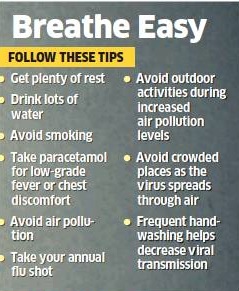
These vibrations are modulated by the person into speech or singing. Phonation is caused by the passage of air over the vocal cords in the larynx, causing vibrations, similar to the vibrations of the reed in an organ or clarinet. The movement of gases through the mouth, larynx, and pharynx allows a person to speak (phonate) or sing. It is also known that smoking causes lung and mouth cancer VOCALIZATION In addition, many tobacco products contain substances (e.g., tars) that can build up in the lungs. These factors can all result in a decrease in gas exchange. Nicotine causes a decrease in bronchial diameter constriction of blood vessels, a decrease in ciliary function (which assists in moving foreign particles out of the respiratory tract), and it can destroy lung tissue itself over time. Nursing Alert Smoking can decrease the efficiency of the respiratory system.

They are aggravated by such things as pollutants in the air and cigarette smoking.

Mechanical ventilators are often programmed to deliver a sigh breath on a regular basis to increase the client’s comfort. (No one knows why yawning is contagious.) Yawning also equalizes pressure between the middle ear and the outside atmosphere, helping a person to maintain balance and reducing discomfort when flying or deep-sea diving.Ī deep breath can be taken on occasion. Theorists conjecture that yawning is a response to a lack of oxygen or an accumulation of carbon dioxide. The sneezing reflex is similar to coughing, except that the source of irritation is in the nasal passages. The bronchi and trachea have sensory receptors that initiate a cough in response to foreign particles or irritating substances. RESPIRATORY REFLEXESĬoughing and sneezing are protective reflexes needed to dislodge materials from the respiratory passages. Too little CO2 in the blood is called respiratory alkalosis and is most commonly caused by hyperventilation (excessively rapid, deep breathing), but can also be caused by overuse of antacids or can be related to early pulmonary edema or pulmonary embolism. Untreated respiratory acidosis is life-threatening. This condition, known as respiratory acidosis, can be caused by airway obstruction in disorders such as emphysema, severe pneumonia, asthma, and pulmonary edema, as well as in drug overdose. If a person has a breathing disorder, carbon dioxide can build up in the body forming excess carbonic acid and dangerously lowering the blood pH. Key Concept The respiratory system is the major mechanism for excretion and elimination of carbon dioxide (CO2) from the body (CO2 is constantly being produced by the body as a by-product of metabolism.) One such base compound is sodium bicarbonate (NaHCO3), which outside the body is known as baking soda. The bicarbonate ion often combines to form basic compounds, which counteract acids. These ions are important to the buffer system (and the respiratory process is part of the buffer system), which helps the body maintain proper pH levels.The hydrogen ion often combines to form acids, such as hydrochloric acid (HCl). Carbonic acid can break down to form H+ and HCO3~ (hydrogen ion and bicarbonate ion). The respiratory and renal systems interact to maintain homeostasis.Ĭarbon dioxide can alter pH because it reacts with water to form carbonic acid (H2Co3).

Another important function is the regulation of the pH of all body fluids. The primary function of the respiratory system is the exchange of gases.


 0 kommentar(er)
0 kommentar(er)
